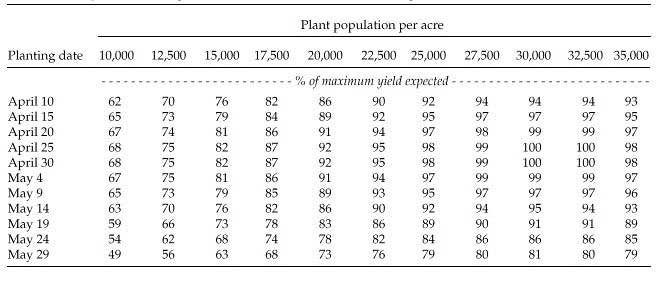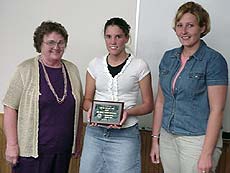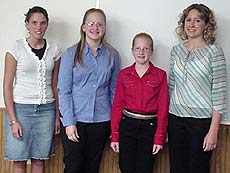|
Features,
Honors
& Awards, Ag
Announcements
Calendar,
Ag News Elsewhere
(fresh daily from the Web)
|
|
Features
|
|
Farm living expenses rise
[MAY
14, 2003]
URBANA -- Total
noncapital living expenses for Illinois farm families rose an
average 2.9 percent between 2001 and 2002 and are up 4.5 percent
since 2000, according to a University of Illinois Extension study.
|
|
"The total noncapital living expenses
of 1,216 farm families enrolled in the Illinois Farm Business Farm
Management Association averaged $44,475 -- or $3,706 a month for
each family," said Dale Lattz, U of I Extension farm management
specialist. "The sample farms, which were mainly grain farms, were
located primarily in central and northern Illinois."
In addition to the living expenses, the
average farm family spent $4,380 in 2002 to buy capital items such
as the personal share of the family automobile, furniture and
household equipment, said Lattz.
"The grand total for living expenses
averaged $48,855 for 2002, compared with $48,097 for 2001," he said.
"This represents a $758 increase per family."

[to top of second column in this
article]
|

Income and Social Security tax payments
decreased in 2002 compared with the year before. The amount of
income taxes paid in 2002 averaged $9,867, compared with $11,475 in
2001.
"The amount of taxes paid was at its
lowest level since 1990," said Lattz.
Medical expenses were higher in 2002
compared with 2001. In 2002, medical expenses averaged $6,335.
"This is the first year medical
expenses averaged over $6,000," Lattz said. "Medical expenses
include out-of-pocket costs for health insurance, along with doctor
and hospital expenses."
The complete
report is available online at
http://www.farmdoc.uiuc.edu/manage/
newsletters/fefo03_09/fefo03_09.html.
[University of Illinois news release] |
|
|
Corn,
soybean costs drop
across Illinois in 2002
[MAY
13, 2003]
URBANA -- Total costs per
acre to produce corn in Illinois dropped an average of 5 percent
from 2001 to 2002, and total costs per acre for soybeans also
dropped over the same period, according to a University of Illinois
Extension study.
|
|
"Total costs to produce corn for all
combined areas of the state were $401 per acre in 2002," said Dale
Lattz, U of I Extension farm management specialist, who wrote the
report, "Costs to Produce Corn and Soybeans in Illinois-2002," based
on data from the Illinois Farm Business Farm Management Association
record-keeping project. "This figure represents a 5 percent decrease
in one year.
"Total costs per acre to produce
soybeans also decreased, from $338 per acre in 2001 to $326 per acre
in 2002."
Driving the decreases, Lattz said, were
reductions in fertilizer, non-land interest charge and land costs.
"For corn, total costs per acre were
the lowest since 1995, when they were $395 per acre," said Lattz.
"Total costs per bushel were the highest since 1997. Total costs per
acre for soybeans were the lowest since 1995."
The entire report is available online
at:
http://www.farmdoc.uiuc.edu/manage/
newsletters/fefo03_08/fefo03_08.html.
Production costs varied among the
state's regions and soil types. Total per acre costs for corn
averaged $411 in the northern section and $416 in the central
section for areas with high soil ratings. Costs were $391 per acre
in the central section for farmland with low soil ratings and $350
per acre in the southern section. Soybean costs in the high soil
areas of northern and central Illinois were $337 and $341
respectively. Costs in the low soil areas of central Illinois were
$312 per acre and $275 per acre in southern Illinois.
[to top of second column in
this article]
|

"Costs were lower in the southern part
of Illinois primarily because of lower land costs," said Lattz. "The
total of all economic costs per bushel in the different sections of
the state ranged from $2.59 to $3.61 for corn and from $6.24 to
$8.09 for soybeans.
"Variations in this cost were related
to weather, yields and land quality. Southern Illinois had the
highest costs per bushel to produce corn and soybeans because of
below average yields caused by last summer's dry weather."
Farms
located in the 22 counties north and northwest of the Illinois River
constitute the northern region. Farms from 36 counties below a line
from about Mattoon to Alton are in the sample for southern Illinois.
The remaining 44 counties make up central Illinois.
[University
of Illinois news release]
|
|
|
StarLink settlement deadline
[MAY
13, 2003]
URBANA -- Most Illinois
farmers face a May 31 deadline to submit a claim in order to receive
their share of a $110,000,000 national settlement recently approved
by the U.S. District Court in Chicago, said Don Uchtmann, University
of Illinois Extension agricultural law specialist.
|
|
"Although quite a few Illinois
producers have submitted their claim, many others are eligible to
participate in the StarLink settlement and receive about $1 or $2
per acre, maybe more, for each acre of non-StarLink corn harvested
as grain in 2000," said Uchtmann.
The exact payment per acre depends on
how many U.S. farmers submit claims.
"If a particular farm operator doesn't
submit a timely claim, that farm operator's share of the settlement
will just be distributed among others who do submit timely claims,"
he said.
"The settlement is a compromise between
farmers who filed the class action lawsuits and the companies that
developed and sold StarLink seed. The class action settlement is
intended to compensate all farmers who grew non-StarLink corn in
year 2000 for damage they allegedly incurred because of the StarLink
incident."
StarLink was a genetically engineered
corn variety approved for feed use in the U.S. but not for food use
or export. After StarLink was discovered in taco shells, aggressive
steps were taken to channel all grain containing traces of StarLink
into approved uses. But the presence of StarLink throughout much of
the 2000 corn supply allegedly scared away buyers and depressed the
U.S. price for the entire crop.
Under the court-approved settlement,
there are several types of potential claims, said Uchtmann, but the
most common type will be the "Corn Loss Proof of Claim" for non-StarLink
corn acres harvested for grain in 2000.

[to top of second column in this
article]
|

"Since very few farmers 'opted out' of
the proposed settlement by the March 21 deadline, over 99 percent of
the year 2000 harvested corn acres are potentially eligible for
payment. About $70 million will be distributed, pro rata, over the
corn acres documented by claimants, but the farm operator must mail
the Corn Loss Proof of Claim by the May 31 deadline," he said.
Farmers who lost the original form
mailed to farmers before March 21 can get a new form and filing
instructions from the Internet. The form is not hard to fill out,
especially if the farmer has copies of the Farm Service Agency forms
(form FSA-578) showing year 2000 corn acres for each farm. FSA
offices can provide a copy of this form if needed. The form asks for
acres of corn but does not request yield information.
"It's the farm operator who submits the
form," said Uchtmann, "and then the farm operator has a
responsibility to account to landlords who shared in the crop."
An article
titled
"How to file claims by May 31 for compensation from the non-StarLink
farmer's class action settlement" is available on the farmdoc
website. It provides valuable, practical information and tools and a
link to the official
"Non-StarLink Farmer Litigation" website, where the claim form
can be obtained.
[University of Illinois news release] |
|
 |
|
|
Corn progress
[MAY
12, 2003]
With over 90 percent of the
corn planted, at least the first time, it is important to scout
fields at this time for stand evaluation and pest problems.
Beginning with stand evaluation, the rule of thumb is simply that a
decent corn stand at this time of year is probably going to yield as
well, or better, than a replanted one. With another shower this
week, we would be looking at 91 percent maximum yield from a great
stand (30,000 plants) planted May 19, and we can go down to a stand
of 20,000 plants planted between April 20 and May 4 to achieve at
least a 91 percent yield.

|
|
There are no guarantees the second time
around either. That 30,000 plant stand is hard to achieve. Much of
the guesswork comes in from the reason behind stand loss. If
herbicide problems, some insect problems (such as maggot or beetle)
and disease problems are at the core of the stand problem, then the
stand may not dwindle further. If seedling diseases or other insects
(such as grubs, wireworms and cutworms) are the culprits, then
stands may be further reduced.
Scouting programs may give you the
answers needed for your decision. In the case of insects that may
further reduce your stands, many of these do not have rescue
treatments available for them. That means you either live with what
you have, or you replant and use a recommended insecticide at
replanting. Black cutworm damage should show up for the first time
in Logan County this week, based on moth captures in traps and
degree accumulation data. Wireworm and grub problems are also just
beginning to be noticed.

[to top of second column in
this article]
|

Cool, damp conditions also lead to some
of the seedling disease problems, such as penicillium. Many of these
problems can't be evaluated until the permanent root system takes
over (another three weeks or so). The end result is that stands must
be evaluated individually, and you should use the smallest area you
are willing and able to manage differently. At any rate, don't plant
alongside an existing row. That system generally takes yield from
both the old and new planting.
On the
soybean side, stand reductions of 30 percent to 40 percent are
generally not going to yield less than perfect stands that are
replanted. The big thing is the number of gaps and the length of
gaps in stands. The other consideration is the amount of shading
provided by the soybean stand and the effectiveness of the shading
in a herbicide program.
[John
Fulton]
|
|
 |
|
|
Weekly outlook
USDA projections
[MAY 6, 2003]
URBANA -- Market attention
will focus on conditions for new crop corn and the uncertainty
surrounding old crop soybeans in reviewing USDA reports due next
week, said a University of Illinois Extension marketing specialist.
|
|
"While corn
inventories are the smallest in five years, stocks are more than
adequate to meet needs until the new crop is harvested, particularly
if the early planting season leads to an early harvest," said Darrel
Good. "The focus, then, is primarily on weather and yield prospects
for the 2003 crop. The market will evaluate potential crop size in
context of the potential consumption of corn in the 2003-04
marketing year.
"The story for
soybeans is different. While the market will clearly be interested
in the USDA's projections for the 2003-04 marketing year, there is
still considerable uncertainty surrounding the old crop situation."
Good's comments came
as he discussed the May 12 USDA projections of potential supply,
consumption and average price during the 2003-04 marketing year.
Based on March corn
planting intentions of 79.022 million acres, about 72 million acres
should be harvested for grain in 2003. Using a trend yield value
near 140 bushels per acre, the 2003 crop might be near 10 billion
bushels.
"A crop of that size
would be about one billion bushels larger than the 2002 harvest,"
said Good. "The USDA May projection may deviate some from 10 billion
bushels, but a large crop projection is generally expected. What the
market really wants to see is the USDA's projection of consumption
during the 2003-04 marketing year."
Good said the
projection of domestic use should be larger than that for the
current year, based on increased ethanol production and a likely
modest expansion in livestock numbers during the last half of the
2003-04 marketing year.

"Most interest,
however, may be in the USDA's projection of marketing year exports,"
he said. "The early season projection was too optimistic at 2.1
billion bushels last year but was fairly close in the previous two
years. This year's projection will, among other things, reveal USDA
thinking about Chinese corn exports during the upcoming year.
"A projection for a
rebound from the year's anemic level of U.S. exports is expected in
next week's report. Even a 10-billion-bushel crop projection may
result in only a modest increase in projected stock levels by the
end of the 2003-04 marketing year."
December 2003 corn
futures are currently trading only about 9 cents above the contract
low established in March 2003. The trading range for the contract to
date is only 38½ cents. History suggests that the range will be
expanded by at least 20 cents and more likely by 35 cents. Large
crop prospects would likely result in new lows for that contract,
while the high to date of only $2.69 still leaves the door open for
a new high.

[to
top of second column in this article]
|

"The continuation of
large exports of U.S. soybeans and prospects for very small
year-ending stocks have pushed cash soybean prices to the highest
level since the summer of 1998," Good noted. "In its April report,
the USDA projected U.S. soybean exports for the current year at 995
million bushels, or 1.05 billion if the larger-than-normal
projection of residual use is included in the export projection.
"Exports of 1.05
billion bushels would be 58 million less than exported last year.
Through May 1 -- with only 17 weeks left in the marketing year --
cumulative export shipments were reported at 923 million bushels, 29
million more than on the same date last year."
With year-ending U.S.
soybean stocks currently projected at only 145 million bushels,
supplies may not be adequate to meet the current export demand.
Prices may have to go higher to slow the pace of exports, buyers may
have to quickly switch to South American supplies, or U.S. users may
import some soybeans or soybean products before the new harvest is
available. The magnitude of U.S. exports and export sales of
soybeans over the next few weeks will have important price
implications and may continue to overshadow new crop prospects for
now, Good observed.
"Eventually, however,
the prospective size of the 2003 U.S. soybean crop will have a
significant influence on price," he said. "Based on March planting
intentions of 73.182 million acres, harvested acreage of U.S.
soybeans should be near 72.1 million acres in 2003. A trend yield
near 40 bushels per acre then projects to a crop of about 2.884
billion bushels, 154 million larger than the 2002 crop.

"A crop of that size,
however, might result in only a very modest build-up in U.S.
inventories by the end of the 2003-04 marketing year if world
soybean demand remains robust."
November 2003 soybean
futures have reached new life-of-contract highs, trading to $5.65 on
May 5. There is some concern that large areas of heavy rainfall this
past weekend may delay soybean planting.
"However, history would suggest that it
is premature for much concern about the 2003 crop," said Good. "Late
summer weather appears to be much more important in determining
soybean yields than is spring weather. Still, the trading range to
date for November 2003 futures is only $1.12. New highs for that
contract are still expected."
[University
of Illinois news release]
|
|
 |
|
|
Honors
& Awards
|
|
4-H oral
communications contest results announced
[MAY
5, 2003]
Logan County 4-H recently
had its annual oral communications contest. State fair delegates
selected included Emily Bakken, Lincoln, for illustrated speech; Abrigail Sasse, Beason, oral interpretation; Kim Turner, Atlanta,
formal speech; Katie Turner, Atlanta, illustrated speech; Kelly
Cross and Emma Cross, Hartsburg, oral interpretation team; and Meg
Griesheim, Mount Pulaski, illustrated speech. All were blue award
winners. Emily Bakken was selected as the top oral communicator and
received a plaque sponsored by Lincoln IGA.
|
|
Additional blue award winners were
Jenna Opperman, Colleen Pech, Allicent Pech, Zack Huffer, Ryan
Huffer, Rebekah Crider, Andrew Fulton, David Carter, Elizabeth
Carter, David Fulton and Daniel Fulton, all of Lincoln, and Ben Buse
and Max Buse of Beason.
Judges for this year's contests were
Randi Rich of Normal and JoEllen Maske of Mount Pulaski.
Oral
communication is a life skill taught and practiced in 4-H. To find
out more about the program, contact the Logan County Extension
office, 980 N. Postville Drive in Lincoln, or call 732-8289.
[News release by Patty Huffer,
Logan County Extension community worker]
|

 |
|
 |
|
|
Ag
Announcements
|
|
|
|